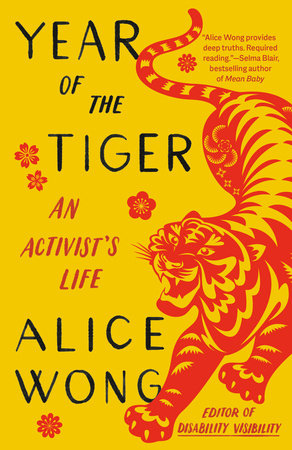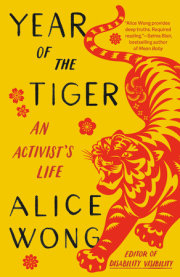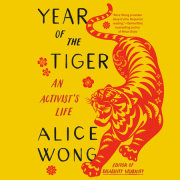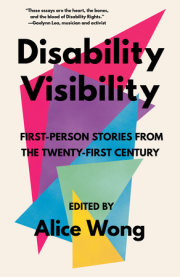Introduction
The book you are reading is from the future, as am I. I have traveled a long way to be with you and have much to share. Spending several decades on Earth has been quite a thing for this disabled Asian American woman in a hostile and unforgiving climate. Clawing, hissing, and fighting through a pandemic, against inequities in vaccine access and eugenic policies and attitudes that consider certain groups disposable, have given me the need to pause and reflect on all that I’ve been through. I have fought these battles for the bare minimum of existing in the same space with you all.
I realized in 2020 that the time to tell my story was now or never. That’s what being a high-risk ventilator user who was deprioritized by the State of California for lifesaving vaccines will do to you. Sheltering in place with your seventy-plus-year-old parents, who are also high risk, for over a year amid anti-Asian violence and hate will do that to you, too. Instead of having a mediocre white man’s midlife crisis and buying a combustible self-driving Tesla or investing in cryptocurrency for “true freedom,” I decided to write a memoir at this age—the age I was never supposed to reach, during a time I was never supposed to occupy. I will never have children, but my work, stories, and relationships are my legacy, and this book you are reading is the latest contribution to the Canon of Alice.
Did I dream of becoming an activist? No, but it’s probably what I’m most known for. Ableism conscripted me into activism. Other people have the luxury to opt in and out of activism like earning extra credit for a project, but not me. What I have learned about creating change and staying true to myself from childhood up to now is yours for the taking. Getting your needs met, being part of a community, stirring up shit, and sharing information: these are examples of my activism, and there are many ways to be an activist whether you use the word to describe yourself or not. How and where I do it is as important as why and whom I do it with. Being agitated and dissatisfied is an activist mood. Activism is undervalued, unsustainable, and unrelenting. Hypercapitalism, white supremacy, and ableism create the structural conditions that undermine activism and other attempts at changing the status quo. Finding the joy, pleasure, and generative possibilities of organizing is part of my long-term unlearning of what activism is supposed to look like. Unlearning and building anew is activism as well.
Living under multiple existential threats, I’ve seen how marginalized communities care for one another and find solidarity across movements, because at the end of the day no one will remember and save us except us. I say this as a longtime resident of San Francisco who cannot remember the last time there was a torrential thunderstorm but who’s had to deal with rolling power outages and days of smoke-filled air from wildfires several years in a row. And in the face of what feels like impending doom, mutual-aid collectives emerge and organizations such as Mask Oakland distribute free N95 masks in anticipation of and response to environmental and public health crises. We can and will do better if we follow the principles of disability justice as outlined by Patty Berne, the cofounder and artistic and executive director of Sins Invalid who believes interdependence is a strength as we meet one another’s needs, all bodies are whole and perfect as they are, our freedom is tied to the freedom of others, and people whose lives are most enmeshed in systems are the experts who should lead.
Year of the Tiger is divided into seven sections: “Origins,” “Activism,” “Access,” “Culture,” “Storytelling,” “Pandemic,” and “Future.” It is a collection of original essays, previously published works, conversations, graphics, photos, commissioned art by disabled or Asian American artists, and more. I hope you will find this book fun and something you will color in, mark up, highlight, scribble on, fold into dog-eared pages, and give to others. I liken it to a mash-up of scrapbook, museum exhibit, magazine, creative writing assignment, and diary, just without the glitter gel pens or stickers. I contain multitudes, and this is a small, playful sample of who I am.
There are many kinds of writing in
Year of the Tiger, but essays are my jam. Whether I publish an op-ed for
Teen Vogue or a blog post on my website, I am taking the time and doing the labor to express what I care deeply about. The economy of an essay forces a writer to be a ruthless, streamlined shark with their ideas. Restraint and precision are part of an essay’s elegance along with its structure. An essay doesn’t have to be in response to or a critique of something else; it can reveal, subvert, wonder, provoke, analyze, celebrate, and poke fun.
Aside from social media, essay writing is my activist tool of choice, my peak creative and intellectual practice, where I layer, condense, finesse, and coax a thought into a Thing. A story from a personal, overlooked perspective can reach more people than a rally and change more minds than a policy paper. For some publications, I have to summon all that I am into eight hundred words or less, which is some damn fine magic. In Dr. Tressie McMillan Cottom’s newsletter
essaying, she wrote, “Beneath all the prose and the argument, an essay is a public. The best essays build a public through process and form, driven from creative impulse to address a social problem. . . . The best scholarship and the most invigorated publics have this in common: They channel massive amounts of creativity. Into relationships. Into methods. Into networks. Into discourse.” It is my intention for every chapter to be in conversation with the others and to ripple out through a mycelial network that builds, shares, and connects My Things to New Wondrous Things, tendrils of making, reaching high and low, in the shade and under the sun.
In writing the proposal for this memoir, I collected some of my past works and was stunned by the volume and the variety. Reviewing cringe-inducing pieces from my high school and college days, I realized every single piece has led me to where I am supposed to be right now. It is a privilege to trace these seeds that grew into sequoias and to highlight the communities that supported me. I planned to have maximum fun in the writing, editing, and assembling process because book stress can always use a chill friend. I tried to let go of my anxieties about memoirs and purposefully did not read an extensive number of them or research comparable ones because I knew it would just mess with my head. This probably goes against most professional advice, but I want to be transparent with you about my process and approach.
Curating myself in words, images, and objects, I was unsure if I had anything new I urgently wanted to write, and why
yes, yes I did! But I also took this opportunity to throw some shade and to lean into my pettiness. I do this not purely for vindictive reasons but as examples of real experiences (with Joan Collins–level receipts) from my everyday life. My redacted texts, rage, and callouts are my truths as much as my activism and storytelling. And for anyone who does not enjoy profanity, consider yourself warned.
Memoir, as a book category, is beset with a number of unique expectations by both the author and the reader. You will not find any pithy themes from this memoir, but that’s what blurbs are for! I resist and challenge the idea that a memoir needs to be neatly digestible with sentimental generalizations about the meaning of life. Since this is my first time writing about myself at length, you should know the following:
• This is not a book that aims to please or center whiteness and nondisabledness.
• This is not a singular success story about overcoming odds, about perseverance or resilience; this is not a “diverse” or “intersectional” book.
• This is not a meditation on identity and pride—that is, whether I am too Chinese or disabled enough—nor a caught-between-two-worlds or my-immigrant-parents-don’t-understand-me story. I am actually not Chinese enough and am very, very disabled, and I am hella okay with that. Haven’t we all seen enough of these types of memoirs, anyway?
• This is not a “harrowing” yet “triumphant” account of discrimination, ableism, humiliation, and pain. I’ve got a bunch of these stories, and you’re going to get only a sliver. I will not excavate my innermost secrets and traumas for your consumption. A memoir can provide only a glimpse of a person, and I am presenting one that is framed by me for nefarious purposes that you may discover one day if you dare.
One of my concerns when writing
Year of the Tiger was about the publishing industry’s propensity to publish memoirs by disabled people as opposed to other types of books they might prefer to write. I don’t have any numbers, but it seems there are more disabled people with memoirs than with graphic novels or cookbooks, with books of photography or poetry, or in genres such as speculative fiction, romance, children’s literature, and
every single other category. Why is that? Is it because readers expect disabled people to have an interest only in explaining disability rather than focusing on their other talents and passions? Is it because disability is more easily understood as an individual phenomenon without broader social and cultural contexts? Is it because it’s more palatable and “humanizing” to learn about one person and the presumed challenges and adversities in their life? Is it because the reader expects a catharsis and warm, empathetic after-school-special fuzzies by the last page?
Is it because they sell? This is not about the authors but about the publishing industry’s estimation of what makes a book attractive and salable—and, in doing so, the power a handful of corporations exerts to decide which disabled people’s stories are worth telling. Like other disabled writers and editors, I am entangled in this web, too.
I’ve read abstracts for a lot of disability memoirs that made my eyes roll all the way to the back of my head. And while I get that audiences vary and there should be a wide range of memoirs, I would venture to say that a majority of them are inspirational, exceptional, heroic, angelic, tale-of-adversity, or courageous narratives. I present to you instead an impressionistic narrative comprising irregular dots that fade, drift, and link rather than a soaring, symmetrical arc. Still, it unsettles me to be in this category and makes me mindful of how my book will be perceived, reviewed, and marketed to the public.
How will the public receive my publics? I await this answer with cautious optimism.
Are memoirs by disabled people the zoo exhibit of the publishing world, allowing the reader (assumed to be a default white, nondisabled, cisgender, heteronormative person) to peer into a life they find equal parts fascinating yet unimaginable? A twenty-first-century spectacle? A reader who wants to feel proud and deserving of diversity points for being a “good” ally after completing it? Whatever reason led you to pick up
Year of the Tiger, I welcome you to question everything when you are done.
Memoirs are valuable because remembering allows us to access our imagination and power. I have willed myself into existence time and time again, and the power of memory is linked with the ability to manifest one’s future. Tiger Power (and caffeine) fuels my travel through portals—it takes a lot of big cat energy to leap into unknown situations, roar against injustice, claw open new spaces, make stealthy moves, and swipe at all who annoy me across the multiverse. For now, I am here at this moment with you and will hold on for as long as I can.
A lot of things remain that I want for me, and there are even more things I want for us. Manifestation requires desire, ambition, sensitivity, and creativity. Each book or story by a disabled person holds a piece of a spell . . . eventually when enough pieces come together and fit, there will be a collective harmonic conjuring. Ripples of energy propelled by momentum, our truths undeniable and irresistible, our messages reverberating far and wide with hidden frequencies just for us. By conjuring our power and manifesting infinite dreams together, the world will finally see us as we are.
A Mutant from Planet CriptonAN ORIGIN
The Nerds of Color blog (April 3, 2014)
In 1974, a baby arrived in the suburbs of Indianapolis, Indiana, from the planet Cripton. She looked like the offspring of two Chinese immigrants, Ma and Pa Wong, but something was different.
Earth’s gravitational force made it difficult for this baby to raise her head. She couldn’t crawl and went straight from sitting to walking. Perplexed, Ma and Pa Wong took their baby to the doctor and found out: she is a mutant from Cripton!
This is her origin story.
This baby alien learned the ways of the Normal quickly; by watching
Sesame Street and reading books, she immersed herself in the cultural mores around her. She communicated and moved in ways that wouldn’t scare the kids on the playground; she knew how to talk to adults when they routinely poked and prodded her. Eventually she grew up and realized that she was not alone, that there were other mutant Crips!
As she came into the age of ascension, Alice (her Earth name) embraced her identity and found power in the community of fellow Crips around her. Scrutinized and labeled deviant by the authorities, Alice and her Siblings of Cripton continue to fight for social justice and equality for mutants and nonmutants alike, even as they face discrimination and oppression for being the Other.
***
So that is my mash-up nerd biography. It’s true, I was born in 1974 to immigrants from Hong Kong, and I am a crip. It’s an understatement to say my love of all things science fiction and cartoons intensely informed my identity as a disabled Asian American woman.
I actually do have a mutated gene—I was “born different” from most babies with a type of muscular dystrophy. I grew up hearing terms such as
weakness,
congenital,
defect,
pathology, and
abnormal associated with me. I didn’t realize the way it assaulted my personhood. Those words transformed into sources of power and resistance as I fell into my imagination through reading, writing, and watching a whole lot of television.
I stopped walking around the age of seven or eight. This separated me from most of my peers who took part in activities that I couldn’t keep up with. Television and the library became my sanctuaries. I distinctly remember being the first person up every Saturday morning because my favorite cartoon,
Super Friends, was on at 7:00 a.m. I think it was my first time seeing an Asian character, Samurai, in a cartoon (and no,
Hong Kong Phooey didn’t count), flying around with his cyclone torso. It was the first time I saw a superpower as a “special” ability.
Super Friends was a unique minority that was valued yet not fully understood.
In elementary school I read Madeleine L’Engle’s
A Wrinkle in Time, and it blew my mind. Many books later, I discovered Octavia E. Butler, and then my mind really became blown. In the trilogy Lilith’s Brood, the Oankali are incredibly perceptive and sensitive aliens. They do not understand humans’ fear of difference. To them, genetic variation is a positive, not a negative.
Like with
Super Friends, I developed an affinity for ensembles such as
Star Trek: The Next Generation,
Star Trek: Deep Space Nine, and, of course,
X-Men: The Animated Series. To have one of the most powerful mutants of them all, Charles Francis Xavier, be a man in a wheelchair absolutely delighted me when I started watching the show in 1992. It was like, “Fuck yeah, just try to talk down to me. I’ll implode your mutant-hating heart.” Actually, that’s more like Magneto’s attitude. Professor X keeps things calm and cool. He commands respect, and his competence is never questioned.
Themes and characters in the X-Men universe resonate with so many communities: LGBTQ+, immigrants, and people with disabilities. The story lines ask a lot of complex questions about assimilation, identity, morality, militarism, and diversity.
There’s something incredibly affirming about seeing yourself reflected in popular culture. In the science fiction, fantasy, and comic book worlds, we may identify with characters like us, characters unlike us, or characters we want to become. Professor X is someone I identify with and aspire to be (although my temperament is a bit more like Magneto’s).
Nerd culture—in books, movies, and television—filled me up and transformed the way I viewed my disability since my nascent origins. Who are nerds if not those left out, ridiculed, neglected, and undervalued by dominant society? Who are nerds if not those who embrace difference, seek community, and support the powerless?
Copyright © 2022 by Alice Wong. All rights reserved. No part of this excerpt may be reproduced or reprinted without permission in writing from the publisher.











